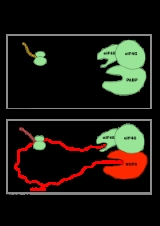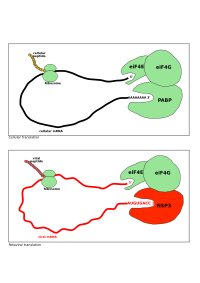
Rotavirus translation
Encyclopedia
Rotavirus translation, the process of translating mRNA into protein
s, occurs in a different way in Rotavirus
es. Unlike the vast majority of cellular proteins in other organisms, in Rotaviruses the proteins are translated from capped but nonpolyadenylated mRNAs. The viral nonstructural protein
NSP3
specifically binds the 3'-end consensus sequence of viral mRNAs and interacts with the eukaryotic translation initiation factor eIF4G. The Rotavirus replication cycle occurs entirely in the cytoplasm. Upon virus entry, the viral transcriptase synthesizes capped but nonpolyadenylated mRNA The viral mRNAs bear 5' and 3' untranslated regions (UTR) of variable length and are flanked by two different sequences common to all genes.
In the group A rotavirus
es, the 3'-end consensus sequence UGACC is highly conserved among the 11 genes. Rotavirus NSP3
presents several similarities to PABP
; in rotavirus-infected cells, NSP3
can be cross-linked to the 3' end of rotavirus mRNAs and is coimmunoprecipitated with eIF4G
. The binding of NSP3A to eIF4G and its specific interaction with the 3' end of viral mRNA brings the viral mRNA and the translation initiation machinery into contact, thus favoring efficient translation of the viral mRNA. NSP3 interacts with the same region of eIF4G as PABP does. As a consequence, during rotavirus infection PABP is evicted from eIF4G, probably impairing the translation of polyadenylated mRNA and leading to the shutoff of cellular mRNA translation observed during rotavirus infection.

Protein
Proteins are biochemical compounds consisting of one or more polypeptides typically folded into a globular or fibrous form, facilitating a biological function. A polypeptide is a single linear polymer chain of amino acids bonded together by peptide bonds between the carboxyl and amino groups of...
s, occurs in a different way in Rotavirus
Rotavirus
Rotavirus is the most common cause of severe diarrhoea among infants and young children, and is one of several viruses that cause infections often called stomach flu, despite having no relation to influenza. It is a genus of double-stranded RNA virus in the family Reoviridae. By the age of five,...
es. Unlike the vast majority of cellular proteins in other organisms, in Rotaviruses the proteins are translated from capped but nonpolyadenylated mRNAs. The viral nonstructural protein
Nonstructural protein
In virology, a nonstructural protein is a protein encoded by a virus but it is not part of the viral particle....
NSP3
NSP3 (rotavirus)
Rotavirus protein NSP3 is bound to the 3' end consensus sequence of viral mRNAs in infected cells.Four nucleotides are the minimal requirement for RNA recognition by rotavirus non-structural protein NSP3: using short oligoribonucleotides, it was established that the minimal RNA sequence required...
specifically binds the 3'-end consensus sequence of viral mRNAs and interacts with the eukaryotic translation initiation factor eIF4G. The Rotavirus replication cycle occurs entirely in the cytoplasm. Upon virus entry, the viral transcriptase synthesizes capped but nonpolyadenylated mRNA The viral mRNAs bear 5' and 3' untranslated regions (UTR) of variable length and are flanked by two different sequences common to all genes.
In the group A rotavirus
Rotavirus
Rotavirus is the most common cause of severe diarrhoea among infants and young children, and is one of several viruses that cause infections often called stomach flu, despite having no relation to influenza. It is a genus of double-stranded RNA virus in the family Reoviridae. By the age of five,...
es, the 3'-end consensus sequence UGACC is highly conserved among the 11 genes. Rotavirus NSP3
NSP3 (rotavirus)
Rotavirus protein NSP3 is bound to the 3' end consensus sequence of viral mRNAs in infected cells.Four nucleotides are the minimal requirement for RNA recognition by rotavirus non-structural protein NSP3: using short oligoribonucleotides, it was established that the minimal RNA sequence required...
presents several similarities to PABP
Eukaryotic translation
Eukaryotic translation is the process by which messenger RNA is translated into proteins in eukaryotes. It consists of initiation, elongation and termination Translation-Initiation:-Cap-dependent initiation:...
; in rotavirus-infected cells, NSP3
NSP3 (rotavirus)
Rotavirus protein NSP3 is bound to the 3' end consensus sequence of viral mRNAs in infected cells.Four nucleotides are the minimal requirement for RNA recognition by rotavirus non-structural protein NSP3: using short oligoribonucleotides, it was established that the minimal RNA sequence required...
can be cross-linked to the 3' end of rotavirus mRNAs and is coimmunoprecipitated with eIF4G
Eukaryotic translation
Eukaryotic translation is the process by which messenger RNA is translated into proteins in eukaryotes. It consists of initiation, elongation and termination Translation-Initiation:-Cap-dependent initiation:...
. The binding of NSP3A to eIF4G and its specific interaction with the 3' end of viral mRNA brings the viral mRNA and the translation initiation machinery into contact, thus favoring efficient translation of the viral mRNA. NSP3 interacts with the same region of eIF4G as PABP does. As a consequence, during rotavirus infection PABP is evicted from eIF4G, probably impairing the translation of polyadenylated mRNA and leading to the shutoff of cellular mRNA translation observed during rotavirus infection.


